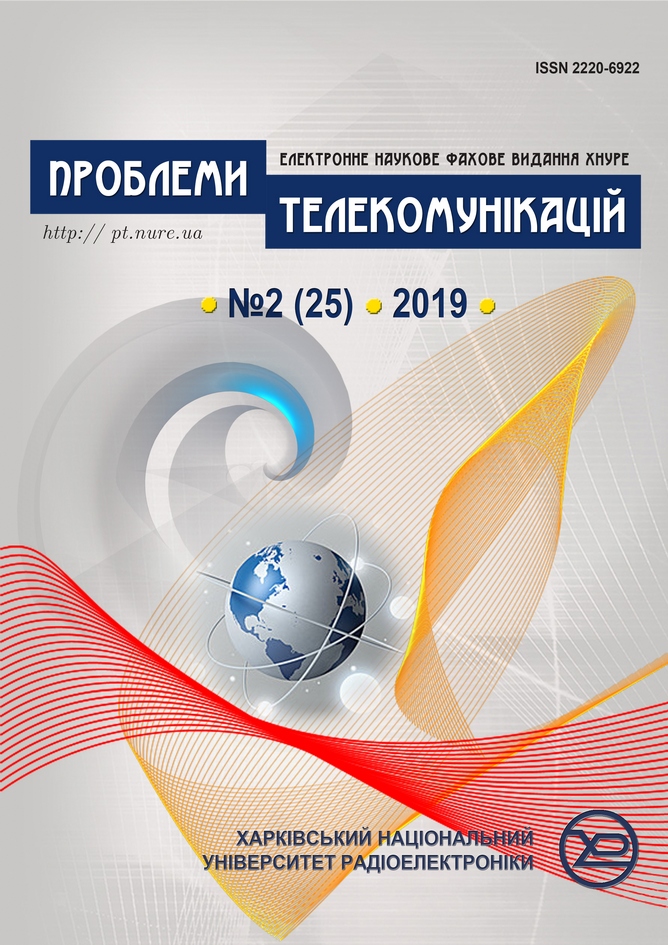Analysis of the algorithm of frequency-time resource allocation in the cognitive radio network
DOI:
https://doi.org/10.30837/pt.2019.2.05Keywords:
Cognitive radio, Resource, Algorithm, Fuzzy logic, CompatibilityAbstract
The cognitive property implies the ability of a radio system to solve the following problems: transition from one standard to another; use of several standards; frequency tuning; the opportunity to participate in the dynamic distribution of the spectrum. One of the problems that arise when allocating a frequency resource may be the lack of clear decision rules. In such cases, as a rule, nonparametric algorithms and methods are used, such as, for example, algorithms based on the mathematical apparatus of neural networks, or algorithms built on the mathematical apparatus of fuzzy logic. An algorithm for the distribution of the time-frequency resource in the cognitive radio network is proposed. A distinctive feature of the developed algorithm is the use of both a parameter of the proportional fair distribution of physical resources PF and SINR. In addition, the decision in this algorithm is based on the mathematical apparatus of fuzzy logic. This algorithm can be used at the stage of network operation in the presence of a large number of speakers and centralized frequency management from the base station. A simulation model for managing the time-frequency resource is developed, with the help of which an analysis of the proposed algorithm is carried out. The analysis showed that the subscriber stations have a very high probability of providing a resource with fully accessible resources and requested resources, which range from 0.1 to 0.5. Subscriber stations are highly likely to provide a resource: with fully accessible resources and requested resources, which range from 0.56 to 0.69; or with the average available resources and requested resources, which are in the range from 0.1 to 0.19. Subscriber stations have an average probability of providing a resource: with fully accessible resources and requested resources that range from 0.69 to 1, or average available resources and requested resources that range from 0.19 to 0.8; or at low available resources and requested resources, which range from 0.1 to 0.32. The subscriber stations have a low probability of providing a resource: with average available resources and requested resources, which range from 0.8 to 1; and with low available resources and requested resources, which lie in the range from 0.32 to 1.References
Tafazolli R. Technologies for the Wireless Future: Wireless World Research Forum (WWRF). John Wiley & Sons. 2006. 520 р.
Burns P. Software defined radio for 3G. Artech house. 2003. 304 p.
Haykin S. Cognitive radio: brain-empowered wireless communications. IEEE journal on selected areas in communications. 2005. №23(2). Р. 201-220.
ETSI TR 102 682 V1.1.1 (2009-07). Reconfigurable Radio Systems (RRS); Functional Architecture (FA) for the Management and Control of Reconfigurable Radio Systems. URL: https://www.etsi.org/deliver/etsi_tr/102600_102699/102682/01.01.01_60/tr_102682v010101p.pdf
ETSI TR 102 683 V1.1.1 (2009-09). Reconfigurable Radio Systems (RRS);Cognitive Pilot Channel (CPC). URL: https://www.etsi.org/deliver/etsi_tr/102600_102699/102683/01.01.01_60/ tr_102683v010101p.pdf
ETSI TR 102 745 V1.1.1 (2009-10). Reconfigurable Radio Systems (RRS); User Requirements for Public Safety. URL: https://www.etsi.org/deliver/etsi_tr/102700_102799/102745/01.01.01_60/ tr_102745v010101p.pdf
ETSI TR 102 838 V1.1.1 (2009-10). Reconfigurable Radio Systems (RRS);Summary of feasibility studies and potential standardization topics. URL: https://www.etsi.org/deliver/etsi_tr/102800_102899/102838/01.01.01_60/tr_102838v010101p.pdf
Mitola J., Maguire G.Q. Cognitive radio: making software radios more personal. IEEE personal communications. 1999. № 6(4). P. 13-18. DOI: https://doi.org/10.1109/98.788210
Mitola J. Cognitive radio for flexible mobile multimedia communications. In 1999 IEEE International Workshop on Mobile Multimedia Communications (MoMuC'99)(Cat. No. 99EX384). 1999, November. IEEE, 1999. P. 3-10. DOI: https://doi.org/10.1109/MOMUC.1999.819467
Гельгор А.Л., Попов Е.А. Технология LTE мобильной передачи данных: учеб. Пособие. СПб.: Изд-во Политехн. ун-та, 2011. 204 с.
Tse D., Viswanath P. Fundamentals of Wireless Communication. New York: Cambridge University Press, 2005. 583 p.
Liu L., Nam Y.H., Zhang J. Proportional fair scheduling for multi-cell multi-user MIMO systems. In 2010 44th Annual Conference on Information Sciences and Systems (CISS). IEEE, 2010. P. 1-6. DOI: https://doi.org/10.1109/CISS.2010.5464834
Крылов В.В., Дли М.И., Голуков Р.Ю. Нечеткая логика и искусственные нейронные сети. М.: Физматиз, 2001. 224 с.
Аунг М.М. Исследование и разработка алгоритмов планирования и приоритетного управления доступом в сетях WiMAX. Автореферат диссертации на соискание ученой степени кандидата технических наук. Московский государственный институт электронной техники. 2010. 148 с.
Downloads
Published
Issue
Section
License
Copyright (c) 2019 Yuliia Kolyadenko, Bohdan Mulyar

This work is licensed under a Creative Commons Attribution-NonCommercial-ShareAlike 4.0 International License.
Authors who publish with this journal agree to the following terms:- Authors retain copyright and grant the journal right of first publication with the work simultaneously licensed under a Creative Commons Attribution License that allows others to share the work with an acknowledgment of the work's authorship and initial publication in this journal.
- Authors are able to enter into separate, additional contractual arrangements for the non-exclusive distribution of the journal's published version of the work (e.g., post it to an institutional repository or publish it in a book), with an acknowledgment of its initial publication in this journal.
- Authors are permitted and encouraged to post their work online (e.g., in institutional repositories or on their website) prior to and during the submission process, as it can lead to productive exchanges, as well as earlier and greater citation of published work (See The Effect of Open Access).

